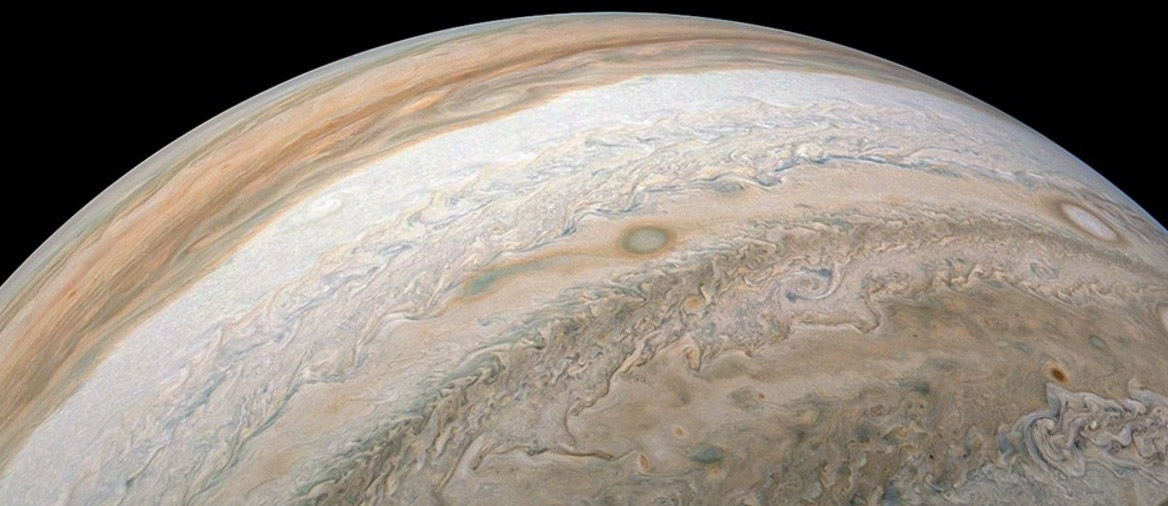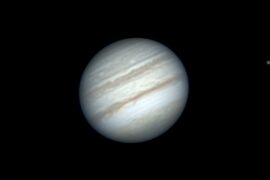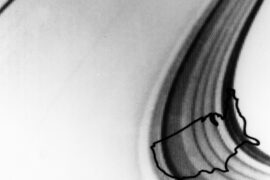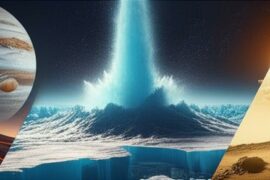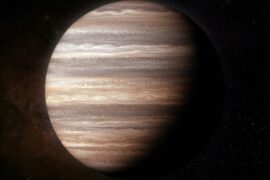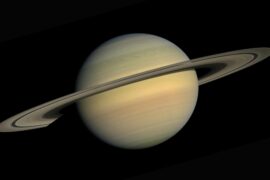Jupiter is one of the most intriguing planets in the Solar system. It is the biggest planet in our neighborhood and is close enough to us to be visible without the help of a telescope. Astronomers have studied it since ancient times, and yet, there’s still so much we don’t know about it.
Jupiter is hard to study because its swirling clouds and fast winds stop us from looking too deep inside and a spaceship would only last a few seconds until the low temperatures and enormous pressures would destroy it. So, a lot of what we know about its inner workings is based on X-ray readings and conjectures.
In this article, we’ll take a look at some of the most fun and interesting questions about Jupiter and their answers.
Question and answers about Jupiter
What is Jupiter made of?
Jupiter is mostly made up of various gases. Approximately 3/4 of the entire planet is just hydrogen. The rest is mostly helium, with just a few traces of other elements. This composition and distribution are very similar to what is seen on some stars, including the Sun, which is why some people believe Jupiter could have become a star if it had gotten any bigger, but more on that below.
We don’t know a lot about Jupiter’s core, but astronomers think that it is a solid or molten core made up of rock, iron, and quartz.
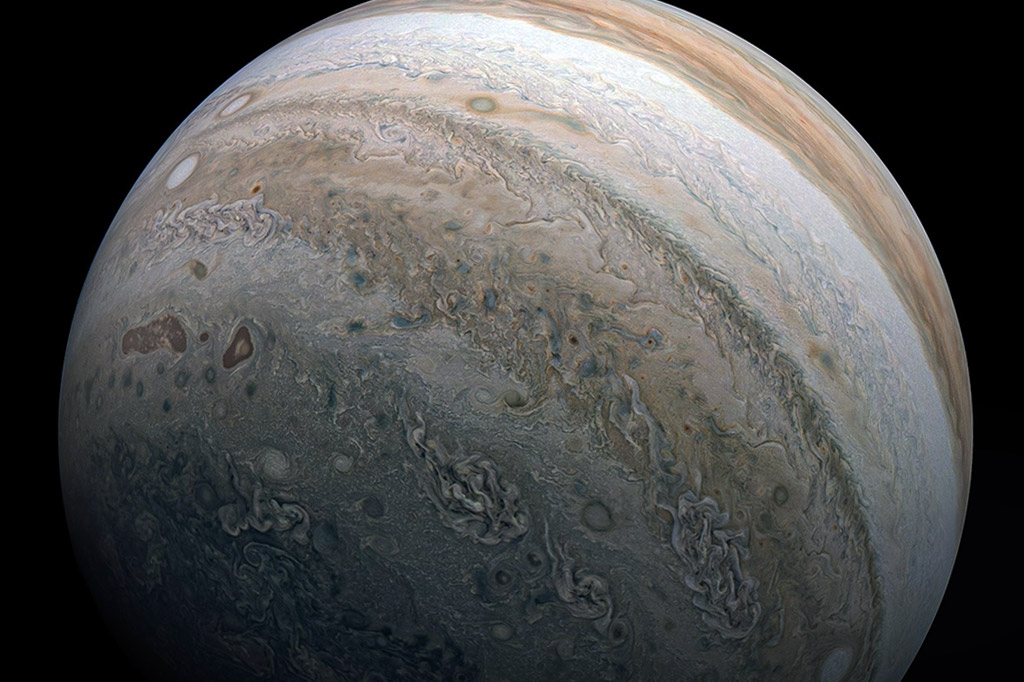
How hot is Jupiter?
Jupiter is very far away from the Sun and doesn’t get that much sunlight compared to Venus or even Earth. And despite the fact that is sometimes compared to a star, it doesn’t fuse any of the hydrogen it contains which means it is not generating heat or energy. So, as it turns out, Jupiter is actually very cold. At least on the outside.
The average temperature in Jupiter’s atmosphere and outer layer is about −185°C (−300°F). For comparison, that is many times colder than the coldest temperatures in Earth’s south pole which reach minimums of −60°C (−76°F).
As you go down Jupiter’s layers things do start to much, much hotter. It is estimated that the temperatures in Jupiter’s core can reach 24,000°C (43,000°F).
Does Jupiter have rings?
Saturn is not the only planet in the Solar system that has rings. As a matter of fact, all of the gas giants, including Jupiter, have rings around them. They are just much smaller and they are not visible from Earth.
Jupiter has 4 sets of rings. They are called the Halo ring, Main ring, Amalthea gossamer ring, and Thebe gossamer ring. All four rings are faint and are mostly made out of tiny pieces of dust and tiny rocks.
The rings were discovered in March of 1979 by the Voyager 1 spaceship as it flew by Jupiter.
Can you walk on Jupiter?
Jupiter is made of gas and some liquified materials. It has no solid surface like Earth or Mars. Everything that you can see in photos of the planet or using a telescope are just the swirling, fast-moving clouds that make up the planet.
So no, it is not possible for a person to walk on Mars because there is no surface to stand on. If you were to “fall” into Mars, you would just sink into the center of the planet. Well, actually, you would be frozen, crushed, and torn apart way before that due to the low temperatures, high pressures, and fast winds.
Is Jupiter a Brown Dwarf?
Brown stars are a very unique category of astronomical objects. They are technically not a star as their name might suggest, but they aren’t planets either. They are large objects made of hydrogen and helium that can’t sustain fusion. Sometimes they are also referred to as “failed stars”.
When you hear that description, it could be understandable to think that Jupiter fits into it, but that’s not the case.
Jupiter is not a Brown dwarf. It is not large enough for it as Brown dwarfs are between 13 and 80 times larger than Jupiter.
We have a more in-depth explanation in the post what is a failed star? if you want to learn more about it.
Who discovered Jupiter?
Jupiter can be seen with the unaided eye under good weather conditions. You don’t need a telescope to see it. Thanks to this, ancient civilizations already knew about it.
We don’t know who was the first person to discover Jupiter because it has been there since the beginning of mankind for everyone to see. The only planets that have an official discoverer are those that require a telescope to be seen. Those are Uranus and Neptune.
What we know is that it was the Greek civilization that named the planets. Jupiter was named after the Roman version of Zeus, the god of thunder and ruler of Olympus in Greek mythology. A very fitting name considering that Jupiter is the biggest planet. It makes you wonder if they knew how big it was.
How big is Jupiter?
Jupiter is the biggest planet in the Solar system. But how big is it really? Well, the planet has a radius of 69,900 kilometers (43,434 miles). For comparison, that is almost 11 times larger than Earth’s radius. If that doesn’t seem impressive enough when you consider that volumetrically, it means that you could fit about 1,300 Earth-sized planets into just one Jupiter.
The second biggest planet is Saturn, with a radius of 58,232 kilometers (36184 miles).
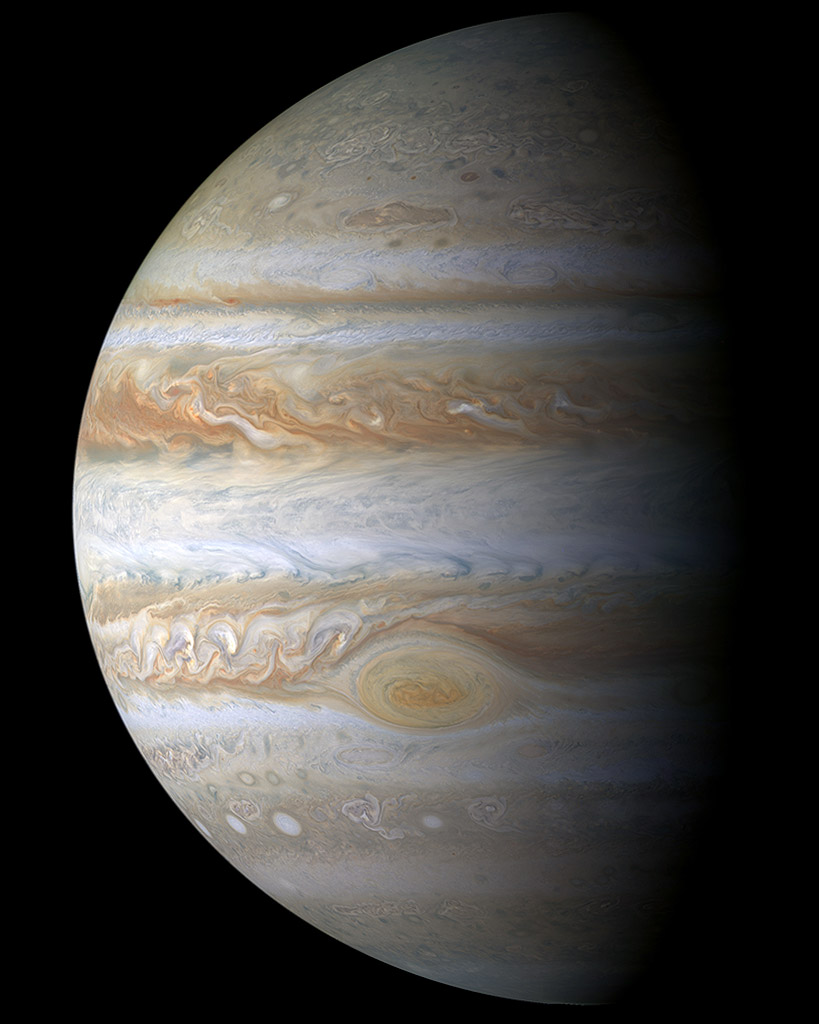
Is Jupiter a shield to Earth?
There is a theory that suggests that a lesser number of meteoroids, comets, and asteroids approach Earth because the larger planets of the Solar system, especially Jupiter, act as some sort of shield that stops many of these objects from going into the inner zones of the Solar system.
This is false.
While it is true that Jupiter does capture a lot of objects thanks to its bigger gravitational pull, the number is not significant enough to be meaningful. The Solar system is huge, and even Jupiter, as large as it is, covers only a tiny portion of it at any given time.
Why is Jupiter much bigger than the other planets?
The short answer to this is that Jupiter is bigger because when the planets were forming, it managed to accrue (collect) more material than the rest. But that doesn’t answer completely the question, right? Why exactly did it have more material around? and how did it happen? those are all great questions that still don’t have exact answers.
There are many theories about it, though. Some scientists believe that after the Sun formed, the majority of gases on the protoplanetary disc (the giant cloud of dust and gas that eventually turned into planets) naturally moved to the outer parts of the Solar system where it was colder. And so, the gas giants formed in that area. Others think that stars don’t allow for large planets to form near them. And others believe it was simply chance.
Solving this question about Jupiter will help us better understand how planets are formed.
Does Jupiter have water?
As you might expect, having no surface means that Jupiter doesn’t have any oceans or poles. So when we ask the question about whether or not Jupiter has water, we are just referring to water in the form of ice or vapor that can be found stored in the planet’s clouds.
The answer is yes. Jupiter does have water. Quite a bit of it actually. About 0.25% of the molecules in Jupiter’s atmosphere consist of water vapor stored on the cloud tops. That doesn’t sound like a lot, but when you consider the size of the planet, it is a considerable amount.
How far away is Jupiter?
Jupiter is the fifth planet in the Solar system. It is located beyond Mars and the asteroid belt. It is considered to be the first of the “outer planets” of the solar system.
Jupiter is located 778 million kilometers (483 million miles) away from the Sun, or 5.2 AU. One “AU” stands for one “Astronomical unit” and it is the average distance from Earth to the Sun. That means that with the number above we can calculate that Jupiter is on average about 4.2 AU away from Earth, or 628 million kilometers (390 million miles) away.
Remember that those numbers are just averages. Planets are always moving across their orbits which means that most of the time they are closer or farther away than that.
Why does Jupiter have so many moons?
At the time of writing, Jupiter has a total of 95 moons. Most of them are quite small and have only been discovered thanks to modern imaging techniques. But still, that’s a lot of moons.
The reason why Jupiter has so many moons is quite simple. Gravity. The planet is so big that throughout its history it has captured a lot of asteroids out of the asteroid belt with its gravitational pull and kept them as natural satellites or moons. It is also possible it has captured passing comets or meteoroids as well.
It is very likely that Jupiter still has more moons that haven’t been detected yet.
Enjoyed this article?
Get daily 10-minute PDFs about astronomy to read before bed!
Sign up for our upcoming micro-learning service where you will learn something new about space and beyond every day while winding down.

